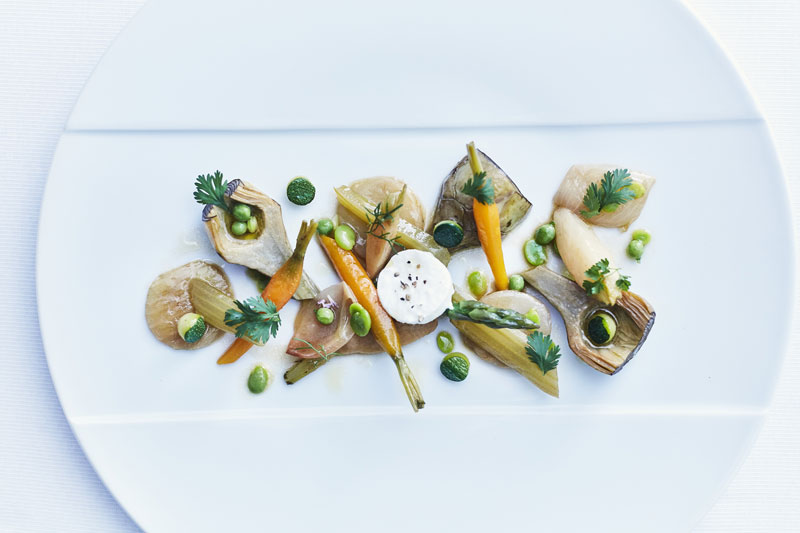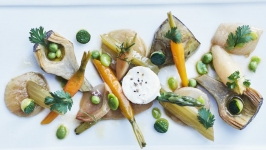The Edible Traveler: Springtime in Old Provence
By Georgeanne Brennan
I came to La Celle to visit its 12th-century abbey and to have lunch at Alain Ducasse’s Hostellerie de l’Abbaye de la Celle. As my friend and I drove down the narrow main street of La Celle, just a few kilometers from the busy La Provençal autoroute and the bustling market town of Brignole, it was like stepping back into old Provence when the pace of life seemed slowed to a human scale.
Plane trees towered above us on both sides, their branches almost forming a canopy over the quiet street. On one side, old men sat outside at cafés that seemed unchanged since the early 1900s, playing cards and drinking pastis. The other side of the street was bordered by a high and ancient stone wall, punctuated by a few doors. One had a sign above it: Maison de Vins du Var. Next along the wall came a pair of pale green arched wooden doors, high enough for a carriage to pass through, and then a smaller door nearby.
We continued down the street, looking for the Hostellerie, but couldn’t find it, even though the address we had was on this street. We turned the car around to look again, and saw, this time, a discreet plaque next to the carriage doors, announcing the Hostellerie. An even smaller sign with an arrow directed visitors to curve left on the road to le parking, which, after turning around once again, we did, to enter through a remote controlled gate.
A vast space opened up before us, framed on one side by several expansive potager gardens filled with late spring and early summer vegetables, and on another side by the stone buildings of the Hostellerie. Vineyards stretched beyond the gardens and le parking to reach the edge of a pine and oak forest.
On stepping from the car, I was immediately struck by the serenity and peace the setting held, a feeling that would be enhanced as the hours passed, first with lunch and then the visit to the abbey. We followed the signs toward the Hostellerie’s restaurant, past a swimming pool almost hidden from sight. Later we learned the inn was built on the ruins of a second-century Roman villa, part of a Roman farm that once occupied the entire area. Ahead, down a flagstone path to our right, we could see a huge green lawn with several large fruiting cherry trees in the center, and directly in front of us, umbrella-shaded tables on a terrace and the ancient stone building behind it.
Like at the restaurant at Alain Ducasse’s other auberge in Provence, the Bastide de Moustiers, near the Gorge du Verdon, the meal began with complimentary crudités: fresh, seasonal vegetables from the garden, housemade breadsticks and an assortment of spreads. Today it was Crème d’Anchois, black olive tapenade and hummus, made, we were told, from local chickpeas. When asked if we’d like an aperitif, we agreed on Billecart-Salmon Rosé. It was a good beginning.
As we sipped our aperitif and nibbled on our appetizers, we soaked in the atmosphere of rustic elegance, the feeling of being one with the natural surroundings, suspended in time and experiencing an overall sense of well-being. It was a warm, clear day in late May and, like us, the other guests and staff were enjoying being outside. In fact, in fine weather, all the restaurant seating is on the terrace. There are three dining rooms inside the auberge, and I suspect it would be just as agreeable to be there in winter with a fire going in the fireplace, even with rain pouring outside.
The restaurant, which has had a Michelin star since 2006, is just as popular with locals as with visitors, and it’s not surprising to see a local vintner arrive with a few bottles and a coterie of friends and family who seem to know everyone.
The young chef, Nicolas Pierantoni, grew up in La Celle and, as he tells the story, growing up, he watched the daily progress of the hotel and restaurant being restored, and dreamed of someday working there. And he did. He began as a teenager, working there for several years in various capacities, then went on to work in other Ducasse restaurants before returning to La Celle as the second chef at the restaurant. In 2015 he was named head chef.
Not surprisingly, Chef Pierantoni knows all the farmers and foragers in the region, as well as fishermen and fishmongers from the coast, less than an hour away. He prides himself on the freshness of the ingredients he sources and often incorporates the seasonal herbs, vegetables and fruits grown on the property. Each weekday he offers a Menu de Marché, or Market Menu, a three-course prix fixe menu which changes daily, in addition to the five- and six-course menus and à la carte menu. His food is essentially light, the ingredients impeccable and the result is elegant but not fussy.
As we concluded our meal, with individual cherry-almond clafoutis—the cherries, of course, coming from the trees on the edge of the lawn—we vowed we’d come back again and again, and one day stay overnight at the auberge, just to savor the luxury of being totally immersed in the serenity and spirit of old Provence.
Georgeanne Brennan is the author of many books and cookbooks, including her two most recent My Culinary Journey: Food and Fetes of Provence (Yellow Pear Press, 2016) and La Vie Rustic (Weldon Owen, 2017). She lives in Winters, California, where she writes, cooks and runs her online culinary business, LaVieRustic.com






